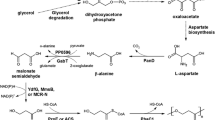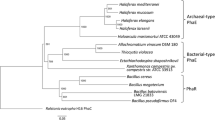Abstract
Previously, we have developed metabolically engineered Escherichia coli strains capable of producing polylactic acid (PLA) and poly(3-hydroxybutyrate-co-lactate) [P(3HB-co-LA)] by employing evolved Clostridium propionicum propionate CoA transferase (Pct Cp ) and Pseudomonas sp. MBEL 6-19 polyhydroxyalkanoate (PHA) synthase 1 (PhaC1Ps6-19). Introduction of mutations four sites (E130, S325, S477, and Q481) of PhaC1Ps6-19 have been found to affect the polymer content, lactate mole fraction, and molecular weight of P(3HB-co-LA). In this study, we have further engineered type II Pseudomonas PHA synthases 1 (PhaC1s) from Pseudomonas chlororaphis, Pseudomonas sp. 61-3, Pseudomonas putida KT2440, Pseudomonas resinovorans, and Pseudomonas aeruginosa PAO1 to accept short-chain-length hydroxyacyl-CoAs including lactyl-CoA and 3-hydroxybutyryl-CoA as substrates by site-directed mutagenesis of four sites (E130, S325, S477, and Q481). All PhaC1s having mutations in these four sites were able to accept lactyl-CoA as a substrate and supported the synthesis of P(3HB-co-LA) in recombinant E. coli, whereas the wild-type PhaC1s could not accumulate polymers in detectable levels. The contents, lactate mole fractions, and the molecular weights of P(3HB-co-LA) synthesized by recombinant E. coli varied depending upon the source of the PHA synthase and the mutants used. PLA homopolymer could also be produced at ca. 7 wt.% by employing the several PhaC1 variants containing E130D/S325T/S477G/Q481K quadruple mutations in wild-type E. coli XL1-Blue.




Similar content being viewed by others
References
Altschul SF, Madden TL, Schaffer AA, Zhang J, Zhang Z, Miller W, Lipman DJ (1997) Gapped BLAST and PSI-BLAST: a new generation of protein database search programs. Nucleic Acids Res 25:3389–3402
Amara AA, Rehm BH (2003) Replacement of the catalytic nucleophile cysteine-296 by serine in class II polyhydroxyalkanoate synthase from Pseudomonas aeruginosa-mediated synthesis of a new polyester: identification of catalytic residues. Biochem J 374:413–421
Braunegg G, Sonnleitner B, Lafferty RM (1978) A rapid gas chromatographic method for the determination of poly-β-hydroxybutyric acid in microbial biomass. Eur J Appl Microbiol Biotechnol 6:29–37
Cho JH, Park SJ, Lee SY, Jung YK (2006) Cells or plants having a producing ability of polylactate or its copolymers and method for preparing polylactate or its copolymers using the same. WO/2006/126796
Drumright RE, Gruber PR, Henton DE (2000) Polylactic acid technology. Adv Mater 12:1841–1846
Fukui T, Doi Y (1997) Cloning and analysis of the poly(3-hydroxybutyrate-co-3-hydroxyhexanoate) biosynthesis genes of Aeromonas caviae. J Bacteriol 179:4821–4830
Jung YK, Kim TY, Park SJ, Lee SY (2010) Metabolic engineering of Escherichia coli for the production of polylactic acid and its copolymers. Biotechnol Bioeng 105:161–171
Kawaguchi Y, Doi Y (2002) Kinetics and mechanism of synthesis and degradation of poly(3-hydroxybutyrate) in Alcaligenes eutrophus. Macromolecules 25:2324–2329
Lee SY (1996) Bacterial polyhydroxyalkanoates. Biotechnol Bioeng 49:1–14
Lee SY, Lee KM, Chan HN, Steinbüchel A (1994) Comparison of recombinant Escherichia coli strains for synthesis and accumulation of poly-(3-hydroxybutyric acid) and morphological changes. Biotechnol Bioeng 44:1337–1347
Liebergesell M, Rahalkar S, Steinbüchel A (2000) Analysis of the Thiocapsa pfennigii polyhydroxyalkanoate synthase: subcloning, molecular characterization and generation of hybrid synthases with the corresponding Chromatium vinosum enzyme. Appl Microbiol Biotechnol 54:186–194
Matsumoto K, Aoki E, Takase K, Doi Y, Taguchi S (2006) In vivo and in vitro characterization of Ser477X mutations in polyhydroxyalkanoate (PHA) synthase 1 from Pseudomonas sp. 61-3: effects of beneficial mutations on enzymatic activity, substrate specificity, and molecular weight of PHA. Biomacromolecules 7:2436–2442
Matsumoto K, Takase K, Aoki E, Doi Y, Taguchi S (2005) Synergistic effects of Glu130Asp substitution in the type II polyhydroxyalkanoate (PHA) synthase: enhancement of PHA production and alteration of polymer molecular weight. Biomacromolecules 6:99–104
Matsusaki H, Manji S, Taguchi K, Kato M, Fukui T, Doi Y (1998) Cloning and molecular analysis of the poly(3-hydroxybutyrate) and poly(3-hydroxybutyrate-co-3-hydroxyalkanoate) biosynthesis genes in Pseudomonas sp. strain 61-3. J Bacteriol 180:6459–6467
Mehta R, Kumar V, Bhunia H, Upadhyay SN (2005) Synthesis of poly (lactic acid): a review. J Macromol Sci Polym Rev 45:325–349
Nelson KE, Weinel C, Paulsen IT, Dodson RJ, Hilbert H, Martins dos Santos VA, Fouts DE, Gill SR, Pop M, Holmes M, Brinkac L, Beanan M, DeBoy RT, Daugherty S, Kolonay J, Madupu R, Nelson W, White O, Peterson J, Khouri H, Hance I, Chris Lee P, Holtzapple E, Scanlan D, Tran K, Moazzez A, Utterback T, Rizzo M, Lee K, Kosack D, Moestl D, Wedler H, Lauber J, Stjepandic D, Hoheisel J, Straetz M, Heim S, Kiewitz C, Eisen J, Timmis KN, Düsterhöft A, Tümmler B, Fraser CM (2002) Complete genome sequence and comparative analysis of the metabolically versatile Pseudomonas putida KT2440. Environ Microbiol 4:799–808
Nishikawa T, Ogawa K, Kohda R, Zhixiong W, Miyasaka H, Umeda F, Maeda I, Kawase M, Yagi K (2002) Cloning and molecular analysis of poly(3-hydroxyalkanoate) biosynthesis genes in Pseudomonas aureofaciens. Curr Microbiol 44:132–135
Park SJ, Yang TH, Kim TW, Lee S-H, Kang HY, Lee EJ, Lee SY (2006) Novel copolymer of [poly(MCL 3-hydroxyalkanoate-co-lactate)] and method for preparing the same, Korea patent application 10-2006-0115162; Novel copolymer of [Poly(3-hydroxypropionate-co-lactate)] and method for preparing the same, Korea patent application 10-2006-0116232; Novel copolymer of [poly(3-hydroxybutyrate-co-3-hydroxypropionate-co-lactate)] and method for preparing the same, Korea patent application 10-2006-0116233; Novel copolymer of [Poly(3-hydroxyvutyrate-co-lactate)] and method for preparing the same, Korea patent application 10-2006-0115158; Novel copolymer of [poly(4-hydroxybutyrate-co-3-hydroxypropionate-co-lactate)] and method for preparing the same, Korea patent application 10-2006-0115159); Novel copolymer of [poly(3-hydroxybutyrate-co-4-hydroxybutyrate-co-lactate)] and method for preparing the same, Korea patent application 10-2006-0115160; Novel copolymer of [poly(3-hydroxybutyrate-co-3-hydroxypropionate-co-4-hydroxybutyrate-co-lactate)] and method for preparing the same, Korea patent application 10-2006-0115161
Potter M, Steinbüchel A (2005) Poly(3-hydroxybutyrate) granule-associated proteins: impacts on poly(3-hydroxybutyrate) synthesis and degradation. Biomacromolecules 6:552–560
Rehm BH (2003) Polyester synthases: natural catalysts for plastics. Biochem J 376:15–33
Schubert P, Krüger N, Steinbüchel A (1991) Molecular analysis of the Alcaligenes eutrophus poly(3-hydroxybutyrate) biosynthetic operon: identification of the N terminus of poly(3-hydroxybutyrate) synthase and identification of the promoter. J Bacteriol 173:168–175
Södergård A, Stolt M (2002) Properties of lactic acid based polymers and their correlation with composition. Prog Polym Sci 27:1123–1163
Solaiman DKY (2000) PCR cloning of Pseudomonas resinovorans polyhydroxyalkanoate biosynthesis genes and expression in Escherichia coli. Biotechnol Lett 22:789–794
Song AJ (2004) Cloning of new Pseudomonas sp. MBEL 6-19 polyhydroxyalkanoate synthase genes and their use in the development of recombinant microorganisms. M.S. dissertation, KAIST
Steinbüchel A, Valentin HE (1995) Diversity of bacterial polyhydroxyalkanoic acids. FEMS Microbiol Lett 128:219–228
Taguchi S, Yamada M, Matsumoto K, Tajima K, Satoh Y, Munekata M, Ohno K, Kohda K, Shimamura T, Kambe H, Obata S (2008) A microbial factory for lactate-based polyesters using a lactate-polymerizing enzyme. Proc Natl Acad Sci USA 105:17323–17327
Takase K, Matsumoto K, Taguchi S, Doi Y (2004) Alteration of substrate chain-length specificity of type II synthase for polyhydroxyalkanoate biosynthesis by in vitro evolution: in vivo and in vitro enzyme assays. Biomacromolecules 5:480–485
Takase K, Taguchi S, Doi Y (2003) Enhanced synthesis of poly(3-hydroxybutyrate) in recombinant Escherichia coli by means of error-prone PCR mutagenesis, saturation mutagenesis, and in vitro recombination of the type II polyhydroxyalkanoate synthase gene. J Biochem 133:139–145
Timm A, Steinbüchel A (1992) Cloning and molecular analysis of the poly(3-hydroxyalkanoic acid) gene locus of Pseudomonas aeruginosa PAO1. Eur J Biochem 209:15–30
Vink ETH, Rabago KR, Glassner D, Gruber PR (2003) Applications of life cycle assessment to NatureWorks™ polylactide (PLA) production. Polym Degrad Stab 80:403–419
Yamada M, Matsumoto K, Nakai T, Taguchi S (2009) Microbial production of lactate-enriched poly[(R)-lactate-co-(R)-3-hydroxybutyrate] with novel thermal properties. Biomacromolecules 10:677–681
Yang TH, Park SJ, Kim TW, Lee S-H, Kang HY, Lee EJ, Lee SY (2007) Mutants of PHA synthase from Pseudomonas sp. 6-19 to method for preparing lactate homopolymer or copolymer using the same, Korea patent application 10-2007-0119435
Yang TH, Kim TW, Kang HY, Lee S-H, Lee EJ, Lim S-C, Oh SO, Song A-J, Park SJ, Lee SY (2010) Biosynthesis of polylactic acid and its copolymers using evolved propionate CoA transferase and PHA synthase. Biotechnol Bioeng 105:150–160
Acknowledgements
We thank Sun Ok Oh (LG Chem) for her help with the GPC analysis. This work was supported by LG Chem and by the Korean Systems Biology Research Project (20090065571) of the Ministry of Education, Science and Technology (MEST). Further supports by the World Class University Program (R32-2008-000-10142-0) through the National Research Foundation of Korea funded by the MEST and LG Chem Chair Professorship are appreciated.
Author information
Authors and Affiliations
Corresponding authors
Rights and permissions
About this article
Cite this article
Yang, T.H., Jung, Y.K., Kang, H.O. et al. Tailor-made type II Pseudomonas PHA synthases and their use for the biosynthesis of polylactic acid and its copolymer in recombinant Escherichia coli . Appl Microbiol Biotechnol 90, 603–614 (2011). https://doi.org/10.1007/s00253-010-3077-2
Received:
Revised:
Accepted:
Published:
Issue Date:
DOI: https://doi.org/10.1007/s00253-010-3077-2




